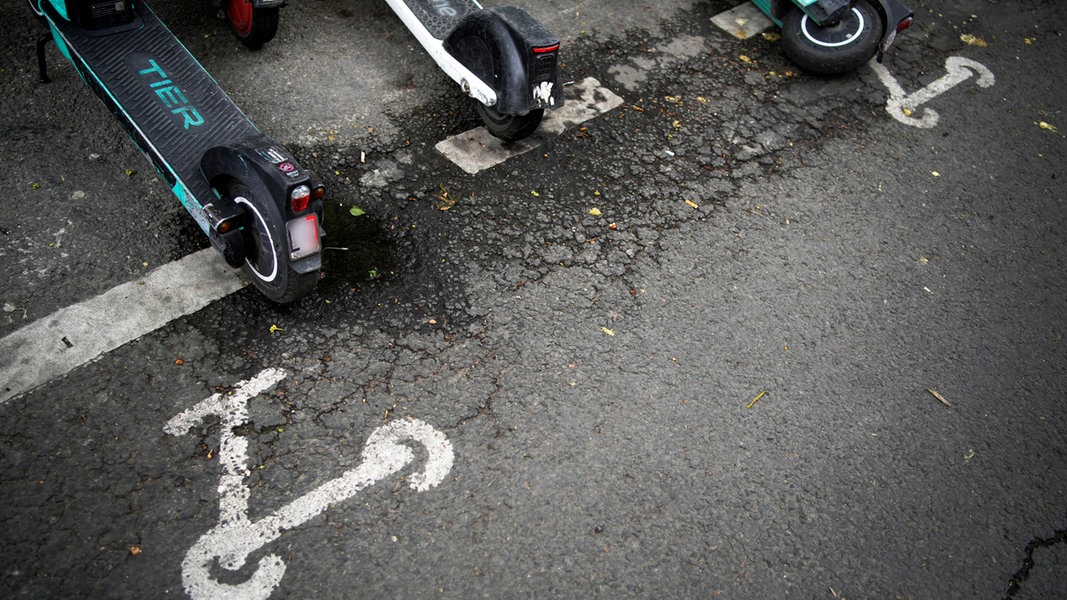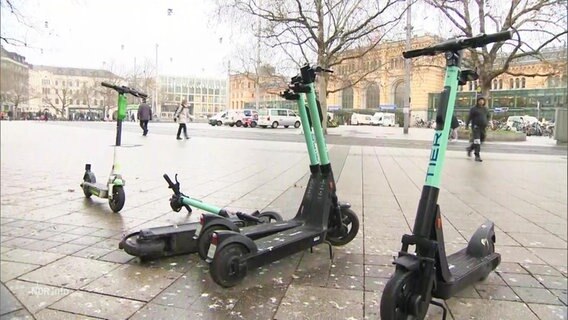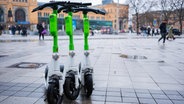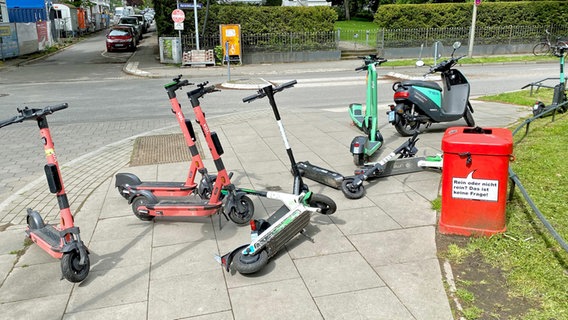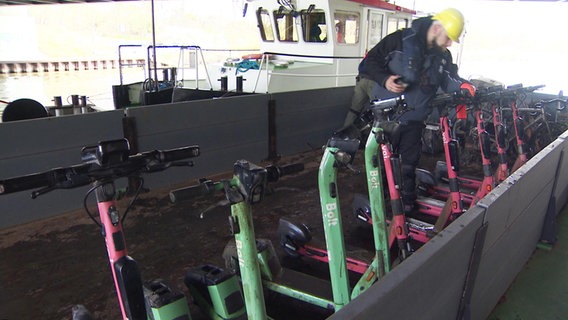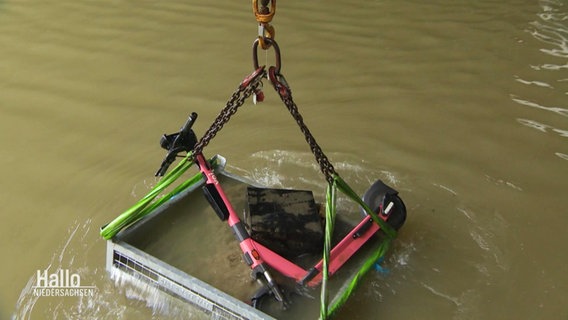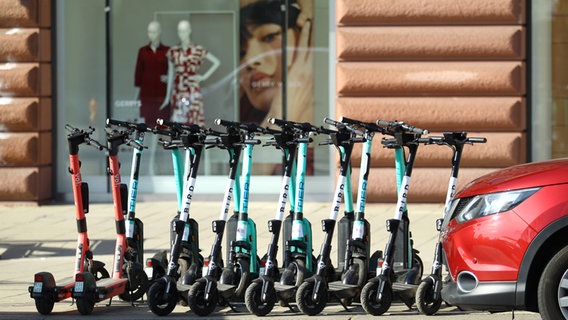Status: 04/05/2023 08:04
Enabling mobility individually – and emission-free. Many manufacturers of e-scooters have been promising this since 2019. But are the fast scooters really good for the climate?
listen to post
5 Min
E-scooters have been rolling through Europe since 2019. At that time, Voi from Sweden was the first provider. The company is now represented in five northern German cities and advertises sustainability: “Punctually and silently from A to B and free of fossil fuels.” However, apart from bold advertising phrases, there is no concrete information on the CO2 footprint on the company’s German-language website. In addition to Voi, the provider Tier, which can even be found in small towns like Elmshorn, advertises that it is climate neutral. However, he can only do this with the help of compensation projects. “In order to achieve climate neutrality, we offset residual emissions that we are currently unable to avoid or reduce through certified climate protection projects,” the website says. After all, the Berlin company publishes one Report on your own carbon footprint.
Further information
E-scooters are more climate-friendly than buses and cars
How climate-friendly are e-scooters really? Semih Severengiz is a professor at the University of Bochum and deals with sustainability in technology. He says that the ecological balance of e-scooters is better than that of local public transport. “The life cycle assessment is the examination of all material and energy inputs that I need and the outputs in the form of emissions that I can measure.” This includes the extraction of raw materials, production, the actual use and the recycling and recycling of the parts.
The so-called life cycle analysis of e-scooters shows that it is more climate-friendly to drive e-scooters than to use a car or bus – if you take the life cycle assessment as a benchmark. And this despite the fact that the e-scooters are also collected for charging with vehicles that drive with combustion engines.
However, the life cycle assessment for local public transport used for comparison is always controversial because it contains average values for capacity utilisation. An English report by the provider Voi, for example, states: “On average, a journey in 2021 in Voi cities emits 29 grams of CO2 equivalents per kilometer.” According to the Federal Environment Agency, a long-distance bus weighs 37 grams per person and kilometer, and a car 162 grams.
Footpaths and bicycle rides are usually replaced
However, the positive environmental balance only applies if the e-scooter does not replace cycling or walking. However, observational studies have shown that this is exactly what usually happens: Many people used the scooters for shorter distances of up to two kilometers. According to EU studies, only about ten percent of trips with e-scooters would replace cars or motorcycles, says Miriam Dross from the Federal Environment Agency. One ETH Zurich study summarized: “Private e-scooters emit less CO2 than the transport methods they replace, while rental scooters (shared e-bikes and e-scooters) emit more CO2 than the transport methods they replace.” However, according to the study maker, rental scooters could lead to more people using private e-scooters in the long term and thus reducing CO2 consumption.
E-scooters should also be on the outskirts
However, e-scooters could already help to make mobility more climate-neutral – if they are used correctly, says Miriam Dross from the Federal Environment Agency. “They could be put to good use in what we call the ‘last mile’. This is practically the journey from the public transport terminal to your home.” Because if the way home from the stop is relatively long, this is an incentive to do without the bus and train and to cover the entire distance directly by car.
For this, however, more e-scooters would have to be at the end stops, i.e. on the outskirts of the city, Dross demands. “There are reasons why they aren’t there. That’s usually because they’re not used to capacity there and, above all, they’re more difficult to collect.” There are now cities that require providers to also place scooters in outlying districts.
Further information
E-scooters end up in water
Some experts also see the e-scooters as an additional environmental problem. Because always land Vehicles in lakes and rivers like the Rhine in Cologne. In Hamburg, too, scooters are regularly pulled from canals and the Alster. However, the police do not have any figures on this. Even the spokesman for Tier does not give any exact figures on request: “Since the start in Hamburg, only a few e-scooters have landed in the Alster and Elbe. Due to the no-parking zones set up near bodies of water, it only happens in rare cases that one our e-scooter ends up in the water.”
E-scooters in the water: batteries as a risk
The scooters are powered by electric batteries containing electrolytes such as sulfuric acid. These could lead to problems in bodies of water, says Reinhart Job, Professor of Energy Storage Technology at Münster University of Applied Sciences. “When a battery like this corrodes in water, the electrolytes are released. A lot of people say: Well, it’s not that bad, it’s just very diluted. But it’s still in there. Fish, for example, can absorb it.” In addition, the electrolytes could settle in standing water in the ground.
Batteries also contain metals such as nickel and cobalt. It is difficult to say what exactly these metals cause in the water. That depends on temperatures and local environmental conditions, says Job. For the lithium built into the lithium-ion batteries of the scooters, there is a clear risk profile as far as the ecosystem is concerned. Lithium is also used as a psychotropic drug to treat depression. “It affects neurotransmitters. If lithium gets into fish, then of course it will trigger something,” says Job.
There is also a risk that the batteries will catch fire under water. While lithium does not ignite through contact with water, water cannot extinguish a lithium fire either.
“Better to use raw materials differently”
Energy storage technology expert Reinhart Job therefore believes that e-scooters are a luxury that we can no longer afford. Because the expansion of electromobility requires a large number of batteries. “We need a lot of lithium for that. But not just lithium, because we still have quite a lot of it worldwide. We also need metals like cobalt for reasonable batteries – and we don’t have that much cobalt worldwide.”
Further information

